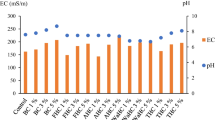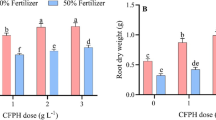Abstract
Using statistical response surface methodology this paper primarily investigates the role of process parameters at different levels (temperature, contact time, and rotation speed) and their influence on yield percentage during the production of chicken feather hydrochar (CFH) as soil amendment. Later, the produced char samples were evaluated before and after washing to assess the phytotoxic effect of seed germination and growth on Acacia auriculiformis through germination index% (GI). The optimized conditions for temperature, contact time, and rotation speed of hydrochar production were 150 °C, 1 h and 105.65 rpm, respectively. The hydrochar yield percentage at optimized conditions was 51.93%. The seed germination test indicated strong phytotoxicity for soil with untreated char, fresh hydrochar extract (FHE) with high doses, and 4 months old hydrochar extract (OHE) but the toxic effect was lower for washed hydrochar extract (WHE). It showed a higher germination rate and growth performance for washed hydrochar extract among all the doses. This study has confirmed the applicability of chicken feather (CF) hydrochar for improving the physical properties of sandy loam soil. Further research into pre-treatment and assessment of hydrochar before field application is required.






Similar content being viewed by others
References
Tronina P, Bubel F (2008) Production of organic fertilizer from poultry feather wastes excluding the composting process. Pol J Chem Technol 10:33–36
Paul T, Halder SK, Das A, Bera S, Maity C, Mandal A, Das PS, Mohapatra PKD, Pati BR, Monda KC (2013) Exploitation of chicken feather waste as a plant growth promoting agent using keratinase producing novel isolate Paenibacillus woosongensis TKB2. Biocatal Agric Biotechnol 2:50–57
Bartels T (2003) Variations in the morphology, distribution, and arrangement of feathers in domesticated birds. J Exp Zool (Mol Dev Evol) 298:91–108
Fraser RDB, Parry DAD (1996) The molecular structure of reptilian keratin. Int J Biol Macromol 19:207–211
Leoci R (2014) Animal by-products (ABPs): origins, uses, and European regulations,Universitas Studiorum.
Brandelli A (2008) Bacterial Keratinases: useful enzymes for bioprocessing agroindustrial wastes and beyond. Food Bioproc Tech 1:105–116
Łaba W, Żarowska B, Chorążyk D, Pudło A, Piegza M, Kancelista A, Kopeć W (2018) New keratinolytic bacteria in valorization of chicken feather waste. AMB Expr 8:9
Saqib NU, Oh M, Jo W, Park SK, Lee JY (2017) Conversion of dry leaves into hydrochar through hydrothermal carbonization (HTC). J Mater Cycles Waste 19:111–117
Naderi M, Vesali-Naseh M (2019) Hydrochar-derived fuels from waste walnut shell through hydrothermal carbonization: characterization and effect of processing parameters. Biomass Conv Bioref. https://doi.org/10.1007/s13399-019-00513-2
Islam MA, Ahmed MJ, Khanday WA, Asif M, Hameed BH (2017) Mesoporous activated coconut shell-derived hydrochar prepared via hydrothermal carbonization-NaOH activation for methylene blue adsorption. J Environ Manag 203:237–244
Zbair M, Bottlinger M, Ainassaari K, Ojala S, Stein O, Keiski RL, Bensitel M, Brahmi R (2000) Hydrothermal carbonization of argan nut shell: functional mesoporous carbon with excellent performance in the adsorption of bisphenol A and diuron. Waste Biomass Valori 11:1565–1584
Melo TM, Bottlinger M, Schulz E, Leandro WM, de Oliveira SB, de Aguiar Filho AM, El-Naggar A, Bolan N, Wang H, Ok YS, Rinklebe J (2019) Management of biosolids-derived hydrochar (Sewchar): effect on plant germination, and farmer’s acceptance. J Environ Manag 237:200–214
Röhrdanz M, Rebling T, Ohlert J, Jasper J, Greve T, Buchwald R, Frieling PV, Wark M (2016) Hydrothermal carbonization of biomass from landscape management—influence of process parameters on soil properties of hydrochars. J Environ Manag 173:72–78
Belda RM, Lidón A, Fornes F (2016) Biochars and hydrochars as substrate constituents for soilless growth of myrtle and mastic. Ind Crop Prod 94:132–142
Breulmann M, van Afferden M, MüllerRA SE, Fühner C (2017) Process conditions of pyrolysis and hydrothermal carbonization affect the potential of sewage sludge for soil carbon sequestration and amelioration. J Anal Appl Pyrol 124:256–265
Subedi R, Kammann C, Pelissetti S, Taupe N, Bertora C, Monaco S, Grignani C (2015) Does soil amended with biochar and hydrochar reduce ammonia emissions following the application of pig slurry? Eur J Soil Sci 66:1044–1053
Fang J, Zhan L, Ok YS, Gao B (2017) Mini-review of potential applications of hydrochar derived from hydrothermal carbonization of biomass. J Ind Eng Chem 57:15–21
Buss W, Mašek O (2014) Mobile organic compounds in biochar—a potential source of contamination—Phytotoxic effects on cress seed (Lepidium sativum) germination. J Environ Manage 137:111–119
Somtrakoon K, Chouychai W (2013) Phytotoxicity of single and combined polycyclic aromatic hydrocarbons toward economic crops. Russ J Plant Physiol 60:139–148
Busch D, Stark A, Kammann CI, Glaser B (2013) Genotoxic and phytotoxic risk assessment of fresh and treated hydrochar from hydrothermal carbonization compared to biochar from pyrolysis. Ecotox Environ Safe 97:59–66
Bargmann I, Rillig MC, Kruse A, Greef JM, Kücke M (2014) Initial and subsequent effects of hydrochar amendment on germination and nitrogen uptake of spring barley. J Plant Nutr Soil Sci 177:68–74
Schimmelpfennig S, Müller C, Grünhage L, Koch C, Kammann C (2014) Biochar, hydrochar and uncarbonized feedstock application to permanent grassland—effects on greenhouse gas emissions and plant growth. Agric Ecosyst Environ 191:39–52
Ray T, Mondal K (2018) Ethnobotanical study of Munshiganj in Shyamnagar Upazilla, Satkhira, Bangladesh. Am Eurasian J Sust Agric 12:22–31
Bouyoucos GJ (1936) Directions for making mechanical analysis of soils by the hydrometer method. J Soil Sci 42:225–230
Day PR (1965) Particle fractionation and particle-size analysis. In: Black CA et al (eds) Methods of soil analysis. Soil Sci Soci America, Part I, pp 545–567
Jackson ML (1962) Soil chemical analysis. Prentice Hall Inc, New Jersey
Bremner JM, Mulvaney CS (1982) Nitrogen-total. In: Page AL, Miller RH, Keaney DR (eds) Methods of soil analysis, part 2 chemical and microbiological properties, 2nd edn. American Society of Agronomy, Madison, pp 595–624
Olsen S, Sommers L (1982) Phosphorus. In: Page AL, Miller RH, Keeney DR (eds) Methods of soil analysis, Part 2. Chemical and microbiological properties. American Society of Agronomy, Madison, Wisconsin, USA, pp 403–430
Knudsen D, Peterson GA, Pratt PF (1982) Lithium, sodium, and potassium. In: Page AL, Miller RH, Keeney DR(Eds). Methods of soil analysis, part 2. Chemical and microbiological properties. American Society of Agronomy, Madison, Wisconsin, USA, pp 421–422
ASTM (1989) American Society for Testing and Materials, Standard methods for chemical analysis of wood charcoal. ASTM D 1762–84. Philadelphia, Pa, USA
Azad S, Manik MR, Hasan S, Matin A (2011) Effect of different pre-sowing treatments on seed germination percentage and growth performance of A. auriculiformis. J For Res 22:183
Kalderis D, Papameletiou G, Kayan B (2019) Assessment of orange peel hydrochar as a soil amendment: impact on clay soil physical properties and potential phytotoxicity. Waste Biomass Valori 10:3471–3484
Kalderis D, Kotti MS, Méndez A, Gascó G (2014) Characterization of hydrochars produced by hydrothermal carbonization of rice husk. Solid Earth 5:477–483
Reza MT, Wirth B, Lueder U, Werner M (2014) Behavior of selected hydrolyzed and dehydrated products during hydrothermal carbonization of biomass. Bioresour Technol 169:352–361
Tesfaye T, Sithole B, Ramjugernath D, Chunilall V (2017) Valorisation of chicken feathers: characterization of chemical properties. Waste Manage 68:626–635
Zhang JH, Lin QM, Zhao XR (2014) The hydrochar characters of municipal sewage sludge under different hydrothermal temperatures and durations. J Integ Agri 13:471–482
Lavelle P, Spain AV (2005) Soil ecology, chapter 3: soil organisms. Springer, India
Bandyopadhyay AK, Sarkar D (1987) Occurrence of acid saline soils in coastal Sundarbans area of West Bengal. J Indian Soc Soil Sci 35:542–544
Verma JK, Sharma A, Paramanick KK (2015) To evaluate the values of electrical conductivity and growth parameters of apple saplings in nursery fields. Int J Adv Res Eng Appl Sci 4:321–332
Yadav JSP, Sinha TS, Bandyopadhyay AK, Rao KVGK, Biswas CR (1979) Coastal saline soils of India. Bull No. 5, CSSRI, Karnal, 34
Campbell CA (1978) Soil organic carbon, nitrogen and fertility. In: Schnitzer M, Khan SV (eds) Soil organic matter. Elsevier, Amsterdam, pp 173–271
Chaffey DR, Miller FR, Sandom JH (1985) A forest inventory of the Sundarbans, Bangladesh; Main report. Project report, Overseas Development Administration, London, U.K 140: 195–196
Carter MR (1990) Relative measures of soil bulk density to characterize compaction in tillage studies on fine sandy loams. Canadian J Soil Sci 70:425–433
Nieto A, Gascó G, Paz-Ferreiro J, Fernández JM, Plaza C, Méndez A (2016) The effect of pruning waste and biochar addition on brown peat based growing media properties. Sci Hortic 199:142–148
Puccini M, Ceccarini L, Antichi D, Seggiani M, Tavarini S, Hernandez LM, Vitolo S (2018) Hydrothermal carbonization of municipal woody and herbaceous prunings: hydrochar valorisation as soil amendment and growth medium for horticulture. Sustainability 10:846
Fang J, Gao B, Chen J, Zimmerman AR (2015) Hydrochars derived from plant biomass under various conditions: characterization and potential applications and impacts. Chem Eng J 267:253–259
Al-Wabel MI, Rafique MI, Ahmad M, Ahmad M, Hussain A, Usman AR Pyrolytic and hydrothermal carbonization of date palm leaflets: characteristics and ecotoxicological effects on seed germination of lettuce. Saudi J Biol Sci 26: 665–672
Reza MT, Lynam JG, Uddin MH, Coronella CJ (2013) Hydrothermal carbonization: fate of inorganics. Biomass Bioenerg 49:86–94
Acknowledgements
The authors are highly indebted to TWAS-research grant, RGA No. 17-511 RG/CHE/AS-G-FR 3240300143 for this research.
Author information
Authors and Affiliations
Corresponding author
Additional information
Publisher's Note
Springer Nature remains neutral with regard to jurisdictional claims in published maps and institutional affiliations.
Rights and permissions
About this article
Cite this article
Islam, M.A., Paul, J., Akter, J. et al. Conversion of chicken feather waste via hydrothermal carbonization: process optimization and the effect of hydrochar on seed germination of Acacia auriculiformis. J Mater Cycles Waste Manag 23, 1177–1188 (2021). https://doi.org/10.1007/s10163-021-01209-4
Received:
Accepted:
Published:
Issue Date:
DOI: https://doi.org/10.1007/s10163-021-01209-4




